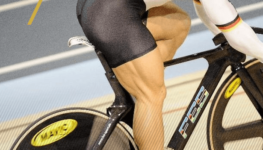Choosing a crank length for optimum performance
Crank Length – why it is important to choose wisely
When it comes to crank length, Martin and I are advocates of shorter being better than longer. Depending on an athlete’s height and leg length, crank lengths of 162.5mm-167.5mm are ideal (the tallest and longest triathletes may need to go to 170mm cranks).
Standard cranks, fitted to standard “off-the-shelf” bikes, are 172.5mm-175mm for most bike sizes except smaller frames.
But what does 5-10mm of difference make?
There are many benefits to shorter crank lengths, the main ones being:
- They reduce hip flexor activation / recruitment – saving them for the run
- Shorter cranks allow for greater torque (rotational force) and recovery
- They reduce overall leg movement / travel
The engineering take on crank length
Out of curiosity and to help understand our reasoning, Barry – one of our coached athletes – did some maths! Being an engineer, calculating is part of his everyday life!
172.5mm Crank length
Crank length of 172.5mm = 17.25cm
Diameter of crank circle = 34.5 cm
Circumference of pedal travel = Pi (π) x 34.5 = 108.3849 cm
Assume constant cadence of 70 rpm, that equates to 4200 revolutions per hour. Assuming a 6-hour bike ride, that equates to 25,200 revolutions.
These figures apply to only ONE LEG! Double the figure to account for both legs.
Considering the amount of movement required to achieve this, each foot must travel around the circumference (dictated by the crank length) as follows:

167.5mm Crank length
 Crank length of 167.5mm = 16.75cm
Crank length of 167.5mm = 16.75cm
Diameter of crank circle = 33.5 cm
Circumference of pedal travel = Pi (π) x 33.5 = 105.243 cm
Using the same assumptions as above of a cadence of 70rpm and a 6-hour ride, there are 25,200 revolutions required.

Comparing the 172.5mm crank with the 167.5mm crank
Conclusion
The 5mm shorter cranks (167.5mm) saves 792 metres of pedal travel, PER leg. This equates to each leg having 754 (1508 total) fewer revolutions over 6 hours.
Just think of the amount of energy this saves for the run!
(If you are a high cadence cyclist, at 90rpm, that equates to 32,400 revolutions per leg in a 6 hour ride and a total foot movement of 35.11km! – or 64,800 revolutions and 70.22km of foot movement if you account for both legs)
Some other blogs worth a read relating to cycling technique and setup
Pedal Technique:
https://mastersoftri.com/__stomping-big-gears/
https://mastersoftri.com/peanuts-8s-pedal-action/
Cadence for triathlon:
http://blog.trisutto.com/the-great-cadence-debate
Wheel selection:
http://blog.trisutto.com/which-wheel-is-right-for-me/




